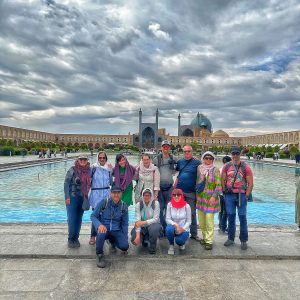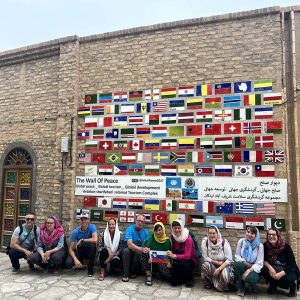
In the past, Iranians came together, sat in the lush exterior of the mansion, and enjoyed the scent of the orange trees, wet soil, jasmine flowers, and fresh fruits in the pool. It is worth noting that the Nine Persian gardens have inscribed by UNESCO as the nomination of \\\’Persian garden\\\’ in 2011. These nine Iranian gardens are a reflection of Persian beauty and unique architecture.’, ‘
Have you ever heard about Persian gardens?
The first thing most tourists traveling to Iran are curious about is probably visiting the Persian gardens. Unlike the almost dry central area of Persia, Iranians have enamored with nature and lush landscapes. Persian gardens have been inspired by paradise, which has green lands, towering trees, and the stream of cold water.
In the past, Iranians came together, sat in the lush exterior of the mansion, and enjoyed the scent of the orange trees, wet soil, jasmine flowers, and fresh fruits in the pool.
It is worth noting that the Nine Persian gardens have inscribed by UNESCO as the nomination of \’Persian garden\’ in 2011. These nine Iranian gardens are a reflection of Persian beauty and unique architecture.
Dolat Abad Garden
Bagh-e Dolat Abad, constructed in 1750, is the enthralling garden within the Yazd town. This garden consists of a pavilion, which demonstrates the highest skill of Iranian architects, encircled by different buildings. The extended pool built ahead of the main pavilion. While you are wandering in, smooth air gently caresses your face. Moreover, on the way to the mansion, the grape and pomegranate trees refresh the atmosphere of the garden. The interior part of the pavilion appears exciting to the majority of tourists designed with complicated frame and exquisite stained-glass windows. This garden additionally boasts the foremost elevated wind tower in the world, which stands over 33.8m height.
Chehel Sotoun Garden
Bagh-e Chehel Sotoun virtually called \”Forty Columns\” is a pleasure pavilion and reception hall in a beautiful and vast garden. Shah Abbas II completes this garden at the end of the sixteenth century in Isfahan city. The title of this Safavid-era complex, which means \”Forty Columns\” in Persian, was galvanized by the twenty Doric wooden columns abutting the doorway of the pavilion when reflecting on the water of the pool seem to be forty. In the higher part of the pool, the Anahita sculpture shield the water. Also, the hall (Throne Hall) has richly adorned with miniatures and ceramics.
Eram Garden
Bagh-e Eram is a lovely garden in Hafez\’s town, Shiraz . The \”Eram\” is the Persian word that implies \”heaven.\” This garden is illuminating the word \”heaven,\” which has expressed in the holiest of books, the Quran as water flow within the irrigation channels and plants glisten beneath the sunlight. Eram garden and its mansion were constructed during the middle of the thirteenth century by the Ilkhanate. The designer of this building is Mohammad Hasan designing with 32 rooms in two stories and tiling with poems of Hafez.
Fin Garden
Bagh-e Fin located in Kashan Isfahan province has designed for Shah Abbas I in the sixteenth century. This aesthetic garden, with its evergreen and five-hundred-year-old cedars and turquoise-tiled pools, which their water channels flowing crystal-clear warm water around the garden, can be the reflection of the epitome of the Persian garden. This Iranian garden consists of 2 pavilions and one Iranian hammam alongside the garden, known because of the murdering of Amir Kabir, the prime minister of the Qajar dynasty, in this Bathroom. Another place in this garden is the Kashani National museum, which can be impressive for a glance.
Abbas Abad Garden
Bagh-e Abbas Abad is a pearl in Mazandaran built by the order of Shah Abbas, the great within the southeast of Behshahr in the northern Jungle of Iran. Abbas Abad garden has a distinct feature because it is the most outstanding non-desert garden in Iran and consists of a tower and mansion in the middle of the lake, which has given scenic beauty to the garden.</p>
Shahzadeh Garden
Bagh-e Shahzadeh means the Prince\’s Garden in Farsi and locates near Mahan, Kerman province. The garden was designed for Mohammad Hasan Khan Sardari Iravani in 1850 and entirely reshaped and extended around 1870 by Abdolhamid Mirza Naserodolleh. It is a rectangular oasis encircled by a brown desert. This garden has two-floor residential construction and pavilions. The space between tents adorned with water fountains that flow by the natural incline of the land.
Pahlavanpur Garden
Bagh-e Pahlavanpur found in Mazvir Abad Neighborhood in Mehriz, Yazd province. This garden has belonged to Mr. Ali Pahlavanpour, who was a well-known merchant. The plan of the garden consists of a doorway, Belvedere, larder, winter mansion, Bathroom, and kitchen. When we enter the building, one amongst the foremost exciting part is the pavilion, adorned with the Karbandi ceiling. Hassan Abad Qanant water flows unceasingly through this vast garden. Besides, the water of ShahHosseini Qanat and Mazvir Abad Qanat flows in the garden to water the plants.
Akbariyeh Garden
Bagh-e Akbariyeh locates in Akbarieh village, Birjand, South Khorasan province. The garden has constructed during the Qajar era. This Persian garden includes lots of mansions, and it is two floors. The oldest mansion is \”Heshmat-ol-Molk\” that found in the eastern section. This garden has several tall pine trees planting on each side of the leading way to show the glory of the Persian garden.
‘, 2, ‘iran visa 24’, ‘Persian Gardens – Feel Persian garden-Persian architecture- Iran visa 24’, ‘The first thing most tourists traveling to Iran are curious about is probably visiting the Persian gardens. Unlike the almost dry central area of Persia, Iranians have enamored with nature and lush landscapes. Persian gardens have been inspired by paradise.’, ‘Persian garden,Persian gardens,Iran UNESCO sites,persian garden cafe,persian garden celebrity,9 Persian gardens,Iran UNESCO heritage,UNESCO heritage,UNESCO world heritage










